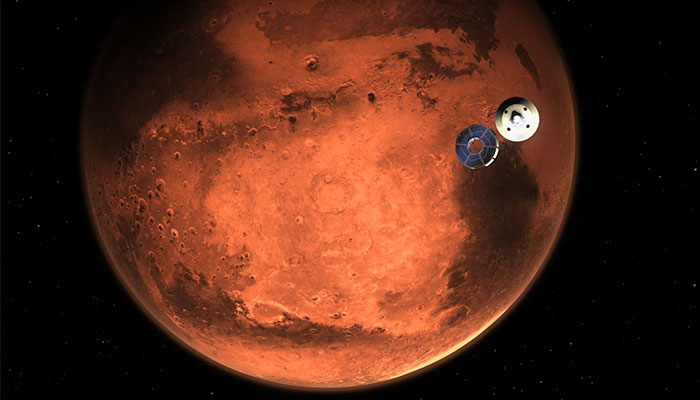On the planet Mars, 470 million kilometres from Earth, is a crater called Jezero. It is situated on the boundary between the Red Planet's rugged southern highlands and flat northern lowlands.
Hello, Jezero: NASA's 'trailer' enacting the Mars Perseverance landing. Credit: NASA/JPL-Caltech
At about 47 kilometres across, Jezero formed at a time when water still flowed on the surface of Mars. It is filled with a delta of clay and sediment – run-off from an ancient river valley – and itself was probably once filled. Its name, Jezero, comes from a Slavic word for lake.
It is as good an environment as one might find on Mars for searching for ancient life.
NASA is due to land Perseverance – Percy for short – on Friday morning (AEDT) on the surface of Jezero crater, described by NASA as the most challenging Martian terrain ever targeted for landing. The rover is part of the Mars2020 mission, along with the small helicopter Ingenuity, which travelled to the Red Planet attached to the belly of the rover and will attempt the first flight in another planet's atmosphere.
Macquarie alumna is a mission leader
Percy, launched from Cape Canaveral in Florida on July 30 last year, has a suite of seven instruments that make it the most advanced astrobiological rover to touch down on Mars.

Reach for the stars: Dr Abigail Allwood is the first female, and first Australian, principal investigator on a NASA Mars mission. She completed her PhD in Earth Science at Macquarie University in 2006.
These instruments include a Norwegian radar (RIMFAX) to search for water and ice underground, and determine the sediments beneath the crater; a UV Raman/luminescence instrument (SHERLOC) to scan mineralogy, but also search for organic compounds; and PIXL, an X-ray spectrometer to measure the element composition of the surface sediments and rock – and whose principal investigator, Dr Abigail Allwood, is a Macquarie alumna and the first female (and first Australian) principal investigator on a NASA Mars mission.
These tools will ascertain the past habitability of the site, but can also search for biosignatures in the geological record. NASA says Perseverance will spend at least one Mars year (two Earth years) exploring the landing site region.
A controversy to settle
The search for ancient life, on Earth or Mars, is fraught with controversy. Most scientists adhere to lauded US astronomer Carl Sagan's maxim on the matter: Extraordinary claims require extraordinary evidence.

Red horizon: A NASA illustration of its Perseverance rover casting off its spacecraft's cruise stage, minutes before entering the Martian atmosphere.
NASA has been burned before – the announcement of life in Martian meteorite ALH84001 in 1996 is generally not accepted now as reaching that high bar.
Perseverance will be the first rover with the capability of detecting subtle Martian biosignatures, and perhaps resolving this debate.
At a time when space seems increasingly crowded by billionaires it is nice to be reminded of why we study planets. To find answers. To explore.
The Martian rovers' names have all shared characteristics of explorers (Curiosity, Spirit). Yet one of the key qualities – Perseverance – was missing.
It seems a timely title for a mission named after the year 2020, and a reminder that despite the hardships, humans are capable of remarkable things.
Dr Craig O'Neill is Associate Professor in the Department of Earth and Environmental Sciences.






